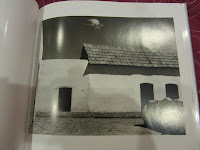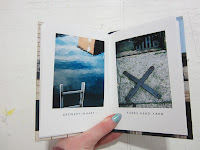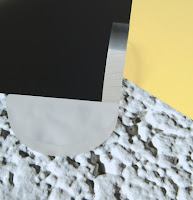Research :
1. Book - Thomas Roma - Found In Brooklyn
This book shows the work of Thomas Roma and a group of photographs that he took in Brooklyn. He wanted to show how Brooklyn is a city within a city and there is a lot to see there. It meant alot to him to show this as he grew up there. The blurb says "Roma looks directly into the mundane and creates poetry, mystery and surprise". This is true as a lot of the pictures are of average looking placed and buildings, often rundown, and Roma makes them look interesting. I really like this concept and I think it would be really interesting to photograph the areas of York that might be run down or neglected and bring out the good in them, and photograph the areas of York which the tourists don't go to.
2. Book - Horst Hamann - New York Vertical
This is a tall, narrow book which shows the work of Horst Hamann. He has photographed New York in a slightly more abstract way than most photographers would. His photographs are often looking up at buildings to emphasise how tall they are and how you can get lost among them. Some of them are really abstract and this makes them really interesting. There is one I really like of the chrysler building where it is just creeping out from behind another building. I like that it is not the main focus of the photograph but you notice it in the background because it is so beautiful. I would like to take some images like this - focusing on something small in the foreground and then just noticing that a popular landmark or place is in the background of the image.
3. Book - Ernst Haas - Thames & Hudson Photofile
I really like the architectural work of Ernst Haas in this book. It reminds me of a couple of projects I did before on my course - Shapes In Architecture and Abstract Fear (CCTV). He photographs architecture in a really abstract way using different angles and perspectives. There's a really nice areal one of lots of people walking down below - I like this idea for my own project as I want to focus on things you wouldn't normally see, and it's not a normal occurance to be that high up that you can see people milling around below. To create a shot like this for my project I would need to get to a high vantage point - such as Clifford's Tower or the York Minster.
4. Book - Paul Strand - Masters Of Photography - Aperture
This book contains the best works of Paul Strand, both architectural and portraits. I am using his architectural work as inspiration for my own project. I really like how simplistic his images are, and how they don't really contain much content but they interest the viewer and make the viewer's eyes wander around the images. I love his use of leading lines, such as the shadow in the top image, and the fence in the bottom image. I like how he has taken photographs of things that aren't particularly interesting, like a white house and a wooden fence, but he has made them look really interesting. I would like to use this technique in my own work and try and photograph simple things and make them look interesting.
5. Book - Eugene Atget - Masters Of Photography - Aperture
I love Eugene Atget's architectural photography. I love how there is nobody in the pictures and it makes the place he is photographing look really quiet and lifeless. I would like to photograph York in this way, as my concept is hidden/unseen York. If there is no one in the pictures it will signify that these places are unseen as no one goes there. I also love how a lot of Atget's photographs lead off into the distance, such as the one looking through an archway or looking down a narrow street. This makes the viewer want to know/see more. To create images with no people in them such as these, in a busy city like York I would need to go out at about 5/6am when the people who have been out at night are going home and the people who are going to work aren't leaving for work yet.
6. Internet Search - Joe Cornish
Joe Cornish is a landscape photographer from the north of England. I love his work, and how he manages to create so much depth within his images. I think he might do this through multiple exposures which he merges together in photoshop. He uses long exposures to create soft clouds and waters. I might like to take some of my photographs like this, using long exposures and a tripod. Doing this might make my images more interesting and give them a bit of a wow factor. I think this process will be trial and error as I am not sure how I would go about creating images like this.
7. Book - Tony Baker - Leeds
This is a book about the not so well known areas of Leeds/the scruffy areas. He has photographed them in a really artistic way and makes them look really interesting. I really love this book and would like to photograph York in a similar way and make the not so nice areas look more attractive. I did a project similar to the images in this book before, called Shapes in Architecture, and I absolutely loved doing it and it was my favourite project I've ever done. Seeing these images reminds me how much I like abstract architecture photography. I really love the way that the colours flow through this book - I will have to think about this when it comes to making my own book for this project and think about how the images will flow when displayed together in a book.
Siskind is famous for photographing details of nature and architecture. He presents them as flat surfaces to create new images of them which he claimed stands independent of the original subject. I really love this concept and would like to photograph York in this way. I would like to crop right into things to make them look abstract, possibly to the point where you don't know what the photograph is of. His work also focuses on shapes which is possibly my favourite thing to photograph. A lot of his photographs contain peeling walls and run down things, I would also like to incorporate this idea into my work as I would like to portray the areas of York which aren't so well kept.
9. Internet Search - Philipp Klinger
Philipp Klinger is an architectural photographer who often makes his images up of shapes. I love his work and think it's really creative and I love how he usually takes his images from straight on and his compositions are usually always central. I love this approach to photography and how he gets a lot into his images, it really makes the viewer's eye want to explore each photograph and look at all of it in detail. As much as I love these images, I think they look too commercial in comparison to what I want to produce for my final major project, however, I would like to take inspiration from his use of colour and shape in his imagery and incorporate it into my own work.
10. Book - Nino Migliori - Walls
This book shows images of walls taken by Nino Migliori. I really like how he has taken a mundane thing such as a wall and made it look really interesting. I especially love the ones which have posters on them that are peeling back or have been ripped off, to reveal older posters underneath. I like his use of colour within the images and how he has displayed different textures. I will explore this idea as I could use a similar technique to portray hidden York, focusing on little aspects of walls and textures and revealing things that you might just ignore in every day life.
11. Internet Search - Mark Rothko
Most of Rothko was a painter who generally created very simplistic work made up primarily of colour. He uses blocks of colour in square or rectangular shapes. I would like to incorporate influences from looking at Rothko's work into my own final major project. I think it would be quite interesting to photograph architecture in blocks of colour, and mix different colours and textures together to show a contrast. Mark Rothko's paintings were all about moods, feelings and emotions. I won't be portraying feelings and emotions through my architecture photographs but I will use the same aesthetic idea to show colour and shape.
12. Internet Search - Mondrian
Mondrian was another painter who worked with colour and shape. His work is very constructed and has a lot of straight lines. I would like to use a lot of straight lines within my images in my final major project. I would like them to look quite clean and straight on. I would like the viewer to be able to see shapes and lines within my work. Mondrian's works often represented cities and their layouts, this relates to my project as I will be working within a city and representing it and it's architecture through my images.
13. Internet Search - Stephen Gill
One of Stephen Gill's projects is called 'Billboards' where he photographed the back of billboards. This is a side that you don't normally see. I don't think I've ever seen the back of a billboard, not that I can remember anyway, because all you really pay attention to is the front and what is on the billboard - such as an advert or poster. I like this concept of things you wouldn't normally see or pay attention to. I would quite like to photograph York in this way and photograph quirky aspects that may be very small and you would walk past them and not look at them during every day life but I would like to show that if you actually stop and look, you realise that there's really interesting things to see. Another thing that I might consider photographing is the back of buildings. Seeing as York is a tourist attraction people will know some of the famous buildings such as the Minster, etc. I could photograph these buildings from the back and show a different side to them.
14. Internet Search - Rachel Mimiec
Rachel Mimiec is another artist who works with colour, line and shape. She quite often takes imagery and paints over it in a bright wash of colour and collage different images and colours together so you initially see the colour blocks but then you look closely and see hidden imagery behind them. I like this idea of hidden things and having to look closely to see details and interesting aspects. I would like to use this concept of hidden aspects of York and uncover little details.
15. Internet Search - Suzanne Mooney
Susan Mooney is a photographer who works with line, colour and shape. She is very interested in sculpture. Her photographs are very abstract and you can't tell what the photograph is of. I really like her work and think it is fascinating. She has used lines and shapes to alter the viewer's perception so they do not know whether one object is in front of another and they can't tell how the image has been composed. I think this is such a clever thing to do and I would love to have a go at that myself and try and incorporate some inspiration from Mooney's work into my own.
16. Internet Search - Cornelia Parker
Cornelia Parker is an artist and photographer who is most famous for her installation work. I came across a set of images that she took of some of the brickwork on the walls outside of Pentonville Prison. She noticed that the lines in which builders had filled in cracks looked like small works of art. She always admired them as she went past them during her every day life, and one day she noticed that they were painting the walls of the prison and were going to be covered up. She then quickly photographed them before they were hidden by fresh paint. She has since then visited different prisons to get different types of imagery. She says that the lines convey meanings, and that the patterns that she'd seen on a female prison were more delicate than the ones she'd seen on a male one.
17. Robert Motherwell
Robert Motherwell was an american painter and printmaker
18.
19.
20.
I am going to take some inspiration from all the people that I have researched and take different aspects of their work and use it within my own to create the bulk of my final major project.































































































No comments:
Post a Comment